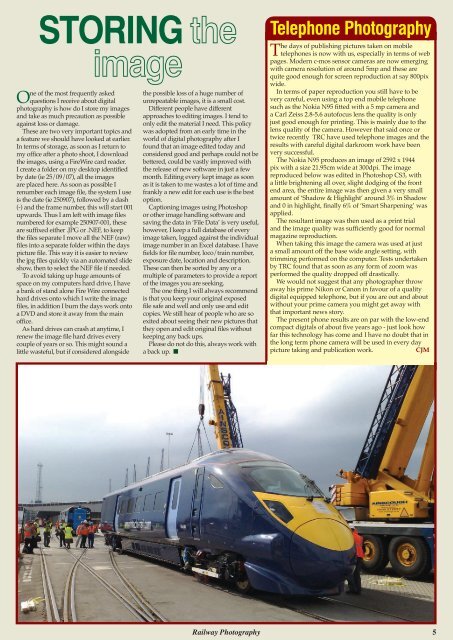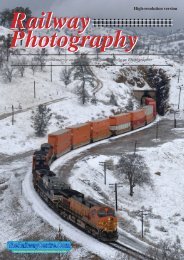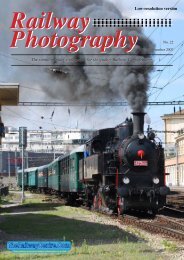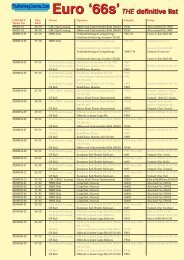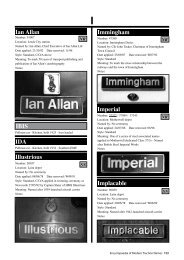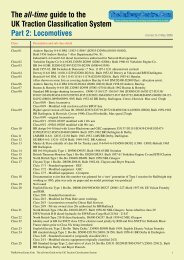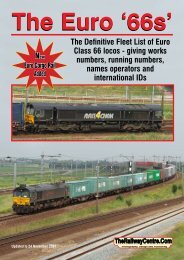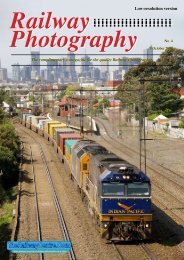Download High Resolution file 7mb - The Railway Centre.Com
Download High Resolution file 7mb - The Railway Centre.Com
Download High Resolution file 7mb - The Railway Centre.Com
- No tags were found...
You also want an ePaper? Increase the reach of your titles
YUMPU automatically turns print PDFs into web optimized ePapers that Google loves.
STORING theimageOne of the most frequently askedquestions I receive about digitalphotography is how do I store my imagesand take as much precaution as possibleagainst loss or damage.<strong>The</strong>se are two very important topics anda feature we should have looked at earlier.In terms of storage, as soon as I return tomy office after a photo shoot, I downloadthe images, using a FireWire card reader.I create a folder on my desktop identifiedby date (ie 25/09/07), all the imagesare placed here. As soon as possible Irenumber each image <strong>file</strong>, the system I useis the date (ie 250907), followed by a dash(-) and the frame number, this will start 001upwards. Thus I am left with image <strong>file</strong>snumbered for example 250907-001, theseare suffixed either .JPG or .NEF, to keepthe <strong>file</strong>s separate I move all the NEF (raw)<strong>file</strong>s into a separate folder within the dayspicture <strong>file</strong>. This way it is easier to reviewthe jpg <strong>file</strong>s quickly via an automated slideshow, then to select the NEF <strong>file</strong> if needed.To avoid taking up huge amounts ofspace on my computers hard drive, I havea bank of stand alone Fire Wire connectedhard drives onto which I write the image<strong>file</strong>s, in addition I burn the days work ontoa DVD and store it away from the mainoffice.As hard drives can crash at anytime, Irenew the image <strong>file</strong> hard drives everycouple of years or so. This might sound alittle wasteful, but if considered alongsidethe possible loss of a huge number ofunrepeatable images, it is a small cost.Different people have differentapproaches to editing images. I tend toonly edit the material I need. This policywas adopted from an early time in theworld of digital photography after Ifound that an image edited today andconsidered good and perhaps could not bebettered, could be vastly improved withthe release of new software in just a fewmonth. Editing every kept image as soonas it is taken to me wastes a lot of time andfrankly a new edit for each use is the bestoption.Captioning images using Photoshopor other image handling software andsaving the data in ‘File Data’ is very useful,however, I keep a full database of everyimage taken, logged against the individualimage number in an Excel database. I havefields for <strong>file</strong> number, loco/train number,exposure date, location and description.<strong>The</strong>se can then be sorted by any or amultiple of parameters to provide a reportof the images you are seeking.<strong>The</strong> one thing I will always recommendis that you keep your original exposed<strong>file</strong> safe and well and only use and editcopies. We still hear of people who are soexited about seeing their new pictures thatthey open and edit original <strong>file</strong>s withoutkeeping any back ups.Please do not do this, always work witha back up. nTelephone Photography<strong>The</strong> days of publishing pictures taken on mobiletelephones is now with us, especially in terms of webpages. Modern c-mos sensor cameras are now emergingwith camera resolution of around 5mp and these arequite good enough for screen reproduction at say 800pixwide.In terms of paper reproduction you still have to bevery careful, even using a top end mobile telephonesuch as the Nokia N95 fitted with a 5 mp camera anda Carl Zeiss 2.8-5.6 autofocus lens the quality is onlyjust good enough for printing. This is mainly due to thelens quality of the camera. However that said once ortwice recently TRC have used telephone images and theresults with careful digital darkroom work have beenvery successful.<strong>The</strong> Nokia N95 produces an image of 2592 x 1944pix with a size 21.95cm wide at 300dpi. <strong>The</strong> imagereproduced below was edited in Photoshop CS3, witha little brightening all over, slight dodging of the frontend area, the entire image was then given a very smallamount of ‘Shadow & <strong>High</strong>light’ around 3% in Shadowand 0 in highlight, finally 6% of ‘Smart Sharpening’ wasapplied.<strong>The</strong> resultant image was then used as a print trialand the image quality was sufficiently good for normalmagazine reproduction.When taking this image the camera was used at justa small amount off the base wide angle setting, withtrimming performed on the computer. Tests undertakenby TRC found that as soon as any form of zoom wasperformed the quality dropped off drastically.We would not suggest that any photographer throwaway his prime Nikon or Canon in favour of a qualitydigital equipped telephone, but if you are out and aboutwithout your prime camera you might get away withthat important news story.<strong>The</strong> present phone results are on par with the low-endcompact digitals of about five years ago - just look howfar this technology has come and I have no doubt that inthe long term phone camera will be used in every daypicture taking and publication work.CJM<strong>Railway</strong> Photography 5


